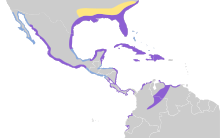
Back أبو منجل أبيض أمريكي Arabic ابو منجل الابيض الامريكى ARZ Eudocimus albus AST Бял ибис Bulgarian Ibiz gwenn Amerika BR Ibis blanc americà Catalan Eudocimus albus CEB Ibis bílý Czech Ibis gwyn CY Hvid ibis Danish
| American white ibis | |
|---|---|

| |
| An American white ibis wading in the Tampa Bay area of Florida | |
| Scientific classification | |
| Domain: | Eukaryota |
| Kingdom: | Animalia |
| Phylum: | Chordata |
| Class: | Aves |
| Order: | Pelecaniformes |
| Family: | Threskiornithidae |
| Genus: | Eudocimus |
| Species: | E. albus
|
| Binomial name | |
| Eudocimus albus | |

| |
Year-round Non-Breeding Passage
| |
| Synonyms | |
| |
The American white ibis (Eudocimus albus) is a species of bird in the ibis family, Threskiornithidae. It is found from the southern half of the US East Coast (from southern New Jersey, Virginia, the Carolinas and Georgia), along the Gulf Coast states (Florida, Alabama, Mississippi, Louisiana and Texas) and south through most of the Caribbean coastal regions of Central America.[2] This particular ibis species is a medium-sized wading bird, possessing an overall white plumage with black wing-tips (usually only visible in flight), and having the typical downward-curving bill of the ibises, though of a bright red-orange color, the same hue as its long legs. Males are larger and have longer bills than females. The breeding range runs along the Gulf and Atlantic Coast, and the coasts of Mexico and Central America. Outside the breeding period, the range extends further inland in North America and also includes the Caribbean. It is also found along the northwestern South American coastline in Colombia and Venezuela. Populations in central Venezuela overlap and interbreed with the scarlet ibis. The two have been classified by some authorities as a single species.
Their diet consists primarily of small aquatic prey, such as insects and small fishes. Crayfish are its preferred food in most regions, but it can adjust its diet according to the habitat and prey abundance. Its main foraging behavior is probing with its beak at the bottom of shallow water to feel for and capture its prey. It does not see the prey.
During the breeding season, the American white ibis gathers in huge colonies near water. Pairs are predominantly monogamous and both parents care for the young, although males tend to engage in extra-pair copulation with other females to increase their reproductive success. Males have also been found to pirate food from unmated females and juveniles during the breeding season.
Human pollution has affected the behavior of the American white ibis via an increase in the concentrations of methylmercury, which is released into the environment from untreated waste. Exposure to methylmercury alters the hormone levels of American white ibis, affecting their mating and nesting behavior and leading to lower reproduction rates.
- ^ BirdLife International (2021). "Eudocimus albus". IUCN Red List of Threatened Species. 2021: e.T22697411A188454802. doi:10.2305/IUCN.UK.2021-3.RLTS.T22697411A188454802.en. Retrieved 4 January 2023.
- ^ Cornell Lab of Ornithology. "White Ibis, Identification". All About Birds. Ithaca, New York: Cornell University. Retrieved 9 January 2012.
